🌐 OpenAPI: The Blueprint of Modern Web Services
✨ What is OpenAPI?
OpenAPI Specification (OAS) is a standard, language-agnostic interface description for RESTful APIs. It allows both humans and machines to understand the capabilities of a service without accessing the source code or additional documentation. Originally known as Swagger, the specification was renamed to OpenAPI after being adopted by the Linux Foundation under the OpenAPI Initiative.
At its core, OpenAPI is a blueprint for your API. It describes the endpoints, methods, parameters, authentication methods, and expected responses of your API in a structured format (usually YAML or JSON). This structured description then becomes a single source of truth from which other tools can generate documentation, testing suites, SDKs, and more.
🌟 Key Features
Language-Agnostic: Works across any platform or programming language.
Machine-Readable: Tools can parse the spec and automate tasks like documentation, testing, and client code generation.
Human-Friendly: Clear and structured format (YAML or JSON) makes it easy to read and write.
Interactive Documentation: Tools like Swagger UI can generate beautiful, interactive docs from your OpenAPI file.
🚀 Why Use OpenAPI?
1. Documentation That Stays Up-to-Date
OpenAPI specs serve as the source of truth. With a well-written spec, your docs can be auto-generated and synced with code changes. This reduces the manual effort and ensures consistency.
2. Improved Collaboration
OpenAPI enables better communication between frontend and backend teams. Frontend developers can understand API behavior just by reading the spec, without waiting for the backend to be deployed.
3. Mock Servers & Testing
You can generate mock servers from your OpenAPI spec for frontend development or automated testing, allowing parallel development.
4. Client and Server Code Generation
Tools can generate SDKs and server stubs in multiple languages based on the OpenAPI file, speeding up development.
5. Contract-First Development
Teams can agree on an API contract (the OpenAPI file) before writing code, which reduces integration errors and ensures everyone is aligned.
⚖️ How OpenAPI Works
Write the Spec: Define your API's structure in a YAML or JSON file.
Use Tools: Import the spec into tools like Swagger UI, Redoc, Postman, or Insomnia.
Integrate with CI/CD: Validate and test APIs as part of your build pipeline.
Generate Code: Create client libraries, server stubs, and documentation from the same file.
🏆 OpenAPI vs Swagger: What's the Difference?
Many people still use "Swagger" and "OpenAPI" interchangeably, but there’s a distinction:
Swagger is a set of open-source tools (Swagger Editor, Swagger UI, etc.) that work with the OpenAPI Specification.
OpenAPI is the actual specification maintained by the OpenAPI Initiative.
Think of OpenAPI as the rules and Swagger as the toolkit to implement those rules.
✅ Real-World Use Cases
FastAPI & NestJS: These frameworks use OpenAPI under the hood to auto-generate docs.
Postman Integration: Import OpenAPI specs to generate test suites and API clients.
Enterprise API Gateways: Tools like Kong and AWS API Gateway use OpenAPI for managing and deploying APIs.
✨ The Future of OpenAPI
As APIs continue to dominate the software landscape, OpenAPI is becoming more critical for:
Microservices architecture
B2B integrations
Public and private API marketplaces
Developer onboarding
Version 3.1 of the OpenAPI Specification introduced even greater support for JSON Schema and improved support for webhooks, making it even more powerful.
🔍 Final Thoughts
OpenAPI is more than a specification — it's a cultural shift in how APIs are built and consumed. It enforces transparency, improves automation, and accelerates development. If you're building APIs and not using OpenAPI yet, you're missing out on a smarter, faster, and more scalable way to build the future of software.
Follow DevTonics for more deep dives into the tools and technologies powering modern development.


